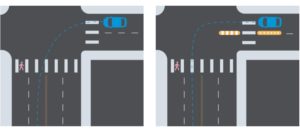SAN FRANCISCO, Calif., November 19, 2021 — As the car crash epidemic rages, behavioral insights offer reliable solutions for safer intersections. Simple intersection redesigns slowed left turn speeds by 17% (1.7 mph) in new research from the Behavioral Insights Team (BIT), San Francisco Municipal Transportation Agency (SFMTA), and Vision Zero SF.
In 2019, four in ten traffic fatalities in San Francisco were caused by left-hand turns. To address the problem, BIT researchers created design changes using low-cost materials that U.S. cities have on hand, like rubber speed bumps and paint. We then ran a high-quality evaluation that showed these redesigns made streets safer for pedestrians and cyclists.
“Pedestrian and cyclist deaths are a growing public health crisis, and streets built to maximize speed continue to put us at risk. We think behavioral science has an important role to play in preventing crashes and giving cities reliable solutions to improve road safety for all.” — Michael Hallsworth, PhD, Managing Director, BIT Americas
Pedestrian safety: A growing public health crisis
Pedestrian safety is an urgent priority. Between 2014–2019, pedestrians made up 62% of crash fatalities in San Francisco. Nationally, 21,450 people are estimated to have died in motor vehicle crashes in the first half of 2021—up 16% from last year. Older adults, people of color, and pedestrians in low-income communities are disproportionately represented.
Unsafe left turns are a behavioral response to streets built for speed
Dangerous left turns are a behavioral issue. In summer 2018, BIT researchers observed left-turn behaviors on San Francisco’s High Injury Network (the 13% of streets where 75% of severe and fatal collisions occur).
When turning left, drivers must process a lot of information quickly—traffic, signals, pedestrians, and more. They develop unsafe behaviors as a result: cutting the corner, speeding, shooting the gap, and others.
We pursued physical interventions to reduce speeds and guide drivers to safety in the moment. Our treatments used inexpensive materials that were quick to install: speed bumps, waist-high delineator posts, and paint.

SFMTA helped us identify 11 intersections with some of the highest crash rates in the city to test. We installed left-turn calming treatments to seven intersections, leaving four untreated as controls. Speeds of 4,460 left turns total were observed over three time periods, once before installation and twice after, from December 2019 to May 2021.
Slower speeds with the potential to reduce pedestrian fatalities
We recorded a speed reduction of 1.7 mph (or 17%) on average at the treated intersections. These results are robust because our study design controlled for influences like weather and traffic changes due to the pandemic. Observations occurred over a relatively long period of time as well, which fortifies our results. Similar traffic studies have been conducted in other major cities, but this is the first to prove that changes to street architecture cause slower speeds.
“Our goals have been to maximize safety on city streets and eliminate traffic deaths, and we will continue to use every tool in our toolkit. The installation of enhanced center lane lines and painted safety zones on 35 more intersections across San Francisco by 2024 will undoubtedly save lives.” — Jeffrey Tumlin, Director of Transportation, SFMTA
Slower left turns save lives. Estimates from New York City reveal that left turns are on average, just 4 mph faster than right turns (9.3 mph versus 5.6 mph), yet they account for three times more injuries and deaths. Applied behavioral science can help slow speeds and make roads safer for everyone.
BIT’s work in San Francisco shows that all U.S. cities can prevent pedestrian deaths with practical investments that yield fast, meaningful improvements in safety. For more details about our work with SFMTA and Vision Zero SF, read the report here.


